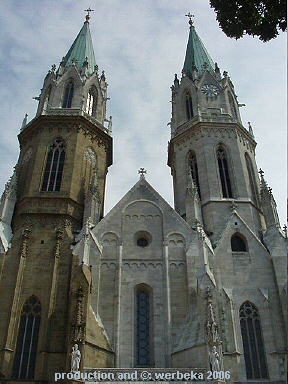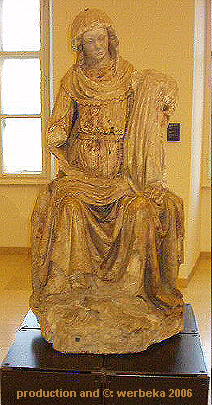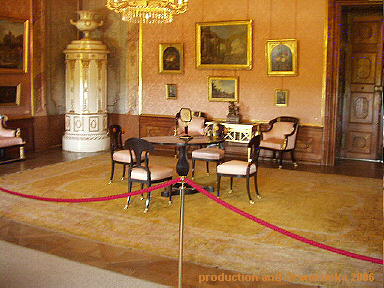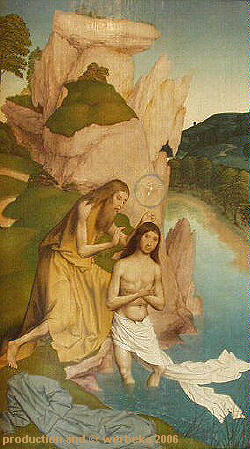
Klosterneuburg monastery
 Klosterneuburg is situated on the Danube, to the northwest of Vienna - the cities border each other directly. The name actually translates as "New castle at the monastery". Historically seen, Klosterneuburg forms part of the Austrian evolution, even if it was only for a short period. Already earlier though, in Roman times, in the first century, exactly as in Vienna, there was a fort, in order to defend the natural border of the Danube against the German tribes in the north. When the Roman Empire declined, the area between the river Enns and Austria's eastern border of today became open space for hordes of more or less savage tribes, among them the Avars and the Huns as well as the horse riding people of Hungarians. First in 955 Emperor Otto could beat the Hungarians decisively. This made it possible, to move the German border eastwards again. In 976 Leopold (Liutpold) I, was appointed Margrave of Austria. (The name of "Ostarrichi" is documented since 996.) He was the first of the dynasty of the Babenbergs, which would govern Austria for a couple of centuries.
Klosterneuburg is situated on the Danube, to the northwest of Vienna - the cities border each other directly. The name actually translates as "New castle at the monastery". Historically seen, Klosterneuburg forms part of the Austrian evolution, even if it was only for a short period. Already earlier though, in Roman times, in the first century, exactly as in Vienna, there was a fort, in order to defend the natural border of the Danube against the German tribes in the north. When the Roman Empire declined, the area between the river Enns and Austria's eastern border of today became open space for hordes of more or less savage tribes, among them the Avars and the Huns as well as the horse riding people of Hungarians. First in 955 Emperor Otto could beat the Hungarians decisively. This made it possible, to move the German border eastwards again. In 976 Leopold (Liutpold) I, was appointed Margrave of Austria. (The name of "Ostarrichi" is documented since 996.) He was the first of the dynasty of the Babenbergs, which would govern Austria for a couple of centuries.
Four generations later, in the year 1095, Leopold III (the only male heir among seven children of Liutpold II) became margrave, at the age of only 20 years. In 1105 he married Agnes, a daughter of the German King Heinrich IV (well-known by his Walk to Canossa). Agnes had a son from her first marriage, Konrad, who later (1128 - 1152), as Konrad III, would become the first German king of the House of Hohenstaufen.

Statue of the Virgin, about 1300
|
For Leopold III those relationships were rather favourable, partly because it strenghtened his influence, partly because Agnes brought a lot of wealth into the marriage.
In 1113 the margrave moved his residency from Tulln to Klosterneuburg. This is an evidence, that the area around the Wienerwald had been secured in the meantime. But already the son of Leopold III, Heinrich "Jasomirgott" II, went one step further and made Vienna his capital.
Before that, in 1114, Leopold and Agnes founded the monastery of Klosterneuburg - the Legend of the Veil tells the background, why that place was chosen. The truth of this maybe whatever, the Verdun Altar is genuine and a very good reason to visit the monastery.
In the 14th century (1330) most parts of the city and the monastery were destroyed by a fire. At the same time the building of the southern tower of the church had been started (on the image to the right). But the tower had to wait until 1592, before it was completed.
1485 is the next year, that is important. Then the founder of the monastery, Leopold III, was cannonized. Due to that, Klosterneuburg became a place of pilgrimage, not at least on November 15th, the saint's day of Leopold. Until today, the "Fasslrutschen" reminds of this tradition. |
At that occasion a huge barrel of wine is climbed over a ladder, in order to glide down on the other side. The Augustinian friars still are among the oldest and biggest producers of wine in the country. In 1860 the world's first school of winegrowing was founded here.
Back to Leopold, though: Through his cannonization he became also the patron saint of the county of Lower Austria; his coat of arms still is the coat of arms of this county.

The Napoleonic Chamber in the Emperor's wing |
In the 17th century the church was rebuilt in Barock style, as well as completed with the northern tower. During the second siege of Vienna by the Turks, in the year 1683, the monastery succeded in holding off the enemy. Becuase of that it became an important base for the rescuing army, which, under the lead of King Jan Sobieski, came along in the last moment and freed Vienna from the Turkish stranglehold.
Emperor Karl VI had big plans. In 1730 he decided to rebuild the monastery into his residence, in the form of the Spanish example of "El Escorial".
|
But only one quarter was finished, because in 1740, after the death of her father, Maria Theresia showed no big interest in Klosterneuburg and moved her attention instead to the castle of Schönbrunn.
At least Karl VI lived in his creation, let be only for one night, on November 15th, 1739. Napoleon also stayed here for a couple of hours, in the Napoleonic Chamber...
In 1879 the church was restored. At this time both of the towers were changed into Gothic style and adjusted to the same hight.
The guiding tour follows roughly the history of the building.

Rueland Frühauf son, beginning 16th century
The baptism of Christ |
Passing a wall from the 12th century, which remains from the palace of Duke Leopold VI, one follows through underground passages to the Verdun Altar. On the way one passes glyphs from the Middle Ages - but it is strictly forbidden to make photos. Anyhow, a sculpture of the Virgin, from about 1300, makes me defy the prohibition order.
(What can be seen here, are global objects of cultural value of all mankind and should not stand under copyright protection in any form. |

Rueland Frühauf son, end 15th century
The Capture of John the Baptist |
But my objection doesn't concern the Klosterneuburg monastery only, but all institutions, which believe that everybody has the possibility to go there in person, in order to see the exhibits.)
The guided tour continues to the Emperor's wing and ends in the monastery's church. After that the visitor is free to walk around in the church, go back to the Emperor's wing and to have a look at the collection of Gothic paintings, which is hung one storey above the Emperor's chambers.
 |
|
The church of the monastery, named "The Birth of the Virgin", seem to be very narrow. This is, because big parts of the church have kept its Romanic origin. It isn't obvious to be seen, though, because of the renovation during the Barock period. At that time were also the side aisles changed into chapels. So, today only the central nave has its original form. In spite of my being fond of the Barock style, in my opinion, it doesn't fit in this narrow church. It makes an overloaded and suffocating impression.
Noticeable are the paintings on the ceiling, which show, apart from the coronation of the Virgin, angels and saints, also the siege by the Turks. Georg Greiner created those works in 1689, that is to say, only six years afterwards. It is normal, that strong emotions were felt for some time after that event. But such a profane subject in a church? Well, one must not forget, that the victory against the Turks also was a victory of Christianity against the Muslims.
|
The high altar is a work by Matthias Steinl and was built in 1728. The altar picture, by Johann Georg Schmidt, shows, fitting the name of the church, the Birth of the Virgin.
© Bernhard Kauntz, Wolvertem, Belgium 2013
Back to  or to the or to the  of of 
15.10.2013 by webmaster@werbeka.com
|

 Klosterneuburg is situated on the Danube, to the northwest of Vienna - the cities border each other directly. The name actually translates as "New castle at the monastery". Historically seen, Klosterneuburg forms part of the Austrian evolution, even if it was only for a short period. Already earlier though, in Roman times, in the first century, exactly as in Vienna, there was a fort, in order to defend the natural border of the Danube against the German tribes in the north. When the Roman Empire declined, the area between the river Enns and Austria's eastern border of today became open space for hordes of more or less savage tribes, among them the Avars and the Huns as well as the horse riding people of Hungarians. First in 955 Emperor Otto could beat the Hungarians decisively. This made it possible, to move the German border eastwards again. In 976 Leopold (Liutpold) I, was appointed Margrave of Austria. (The name of "Ostarrichi" is documented since 996.) He was the first of the dynasty of the Babenbergs, which would govern Austria for a couple of centuries.
Klosterneuburg is situated on the Danube, to the northwest of Vienna - the cities border each other directly. The name actually translates as "New castle at the monastery". Historically seen, Klosterneuburg forms part of the Austrian evolution, even if it was only for a short period. Already earlier though, in Roman times, in the first century, exactly as in Vienna, there was a fort, in order to defend the natural border of the Danube against the German tribes in the north. When the Roman Empire declined, the area between the river Enns and Austria's eastern border of today became open space for hordes of more or less savage tribes, among them the Avars and the Huns as well as the horse riding people of Hungarians. First in 955 Emperor Otto could beat the Hungarians decisively. This made it possible, to move the German border eastwards again. In 976 Leopold (Liutpold) I, was appointed Margrave of Austria. (The name of "Ostarrichi" is documented since 996.) He was the first of the dynasty of the Babenbergs, which would govern Austria for a couple of centuries.





